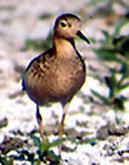The Dancing Shorebird
Buff-breasted Sandpiper
With outstretched wings, a male Buff-breasted Sandpiper tilts its bill upward and does the "shake". Several females scrutinize his dance in their search for the best male to father their young. Nearby, other males dance at their mating posts hoping to attract female attention.
Sometimes a renegade male will sneak on his belly into another male's mating post to disrupt the dance of his competitor, sometimes he will simply fly in and chase females away from his rival, and at other times, he will wait until his rival attracts several females then will walk in while mimicking female behavior and disrupt the copulation of the rival male.
This strange breeding strategy is not unique in the bird world. Referred to as lekking behavior, males will congregate in areas (leks) and exhibit for females that come to choose and then mate with a male. Females sometimes choose more than one male as about 25% of the broods have multiple fathers as has been shown through genetic analysis.
Because of this intense competition for attracting and mating as many females as possible, these males have evolved elaborate courtship displays. Buff-breasted Sandpipers have evolved elaborate behavior in their courtship instead of the gaudier plumages of other lekking species such as the manakins and birds-of-paradise.
As is typical in lekking species, female Buff-breasted Sandpipers raise, shelter and defend their young from predators without help from the males. In fact, the "pair bond" lasts only as long as the mating. After the short mating season is over, males begin their preparations for the long migration southward. Meanwhile, females build simple nests in the treeless Arctic tundra, sometimes near the nests of Black-bellied and American Golden-Plovers. These plovers may act as sentinels thereby providing extra protection for the Buff-breasted Sandpiper young and eggs from Arctic Fox, Ermine, Arctic Ground Squirrels, jaegers, Snowy Owls, ravens, gulls and other predators.
Defense of the young sandpipers is different from many birds in that these young are precocial-that is, they leave the nest within a few hours of hatching and can run and feed themselves. This may be an adaptation for the open terrain with lots of predators in that they for part of the day they can spread out and hide easier than a nest full of nestlings.
Breeding locally in north-slope Alaska and the high arctic of western Canada, Buff-breasted Sandpipers migrate mainly through the Great Plains enroute to their wintering grounds in grasslands of northeastern Argentina, Uruguay, and southern Bolivia. They are usually found in migration and winter at traditional sites from year-to-year often in company of American Golden-Plovers, and Upland and White-rumped Sandpipers. Favorite migration stopovers are short-grass pastures, dry ponds and even baseball diamonds, airports, lawns and other "grasslands".
Nowhere a common species, Buff-breasted Sandpipers rarely congregate but have been occasionally found in groups of 500-2200 in migration and on their wintering grounds. Their populations suffered tremendously from the settling of the Great Plains of North America and the Pampas of South America. Large numbers were shot by market hunters before legislation passed in 1918 (the Migratory Bird Treaty Act) and legislation in 1920 protecting them in Argentina. Concurrently, enormous areas of habitat were converted to agriculture. Protection of their key wintering areas is needed as well as locating and managing their important staging and migration stopover sites.
